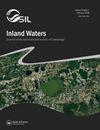Influence of fisheries and shoreline management on limnological characteristics of three Missouri reservoirs
IF 2.3
3区 环境科学与生态学
Q1 LIMNOLOGY
引用次数: 0
Abstract
ABSTRACT Landscape-level analyses based on land cover, morphology, and hydrology account for most of the cross-system variation in pelagic nutrients and suspended solids in Missouri reservoirs. They are based on geometric means, which reduce the influence of extreme temporal variation measured in individual reservoirs. This analysis of 3 conservation reservoirs, managed to benefit recreational fisheries, details how internal processes can alter nutrients, chlorophyll, mineral turbidity, and transparency in long-term (21–42 year) datasets, which contribute to temporal variation. Management practices include the addition of grass carp and herbicides to control nuisance macrophytes and shoreline stabilization with rock and water willow. Among these reservoirs, there is strong evidence that macrophyte removal can increase pelagic nutrients by >90%, resulting in a switch to plankton-dominated conditions (alternative states). In one case, eradication of aquatic vegetation increased mineral turbidity by >60%, which was reversed by reestablishing macrophytes and stabilizing the shoreline. This temporal series supports the modifications of phytoplankton–nutrient relations by mineral turbidity shown in state-wide analyses. Collectively, the long-term data show a significant increase in cyanobacteria biovolume and cyanotoxins, with maximum microcystin concentrations increasing as much as 20 times. Actively flipping lakes to plankton-dominated systems via fisheries management and shoreline stabilization practices has negative impacts on overall water quality, with implications for human and wildlife health.渔业和海岸线管理对密苏里州三座水库湖泊特征的影响
基于土地覆盖、形态和水文的景观水平分析是密苏里水库中上层营养物和悬浮物跨系统变化的主要原因。它们基于几何平均,减少了个别水库测量的极端时间变化的影响。对3个保护水库的分析使休闲渔业受益,详细介绍了内部过程如何改变长期(21-42年)数据集中的营养物质、叶绿素、矿物浊度和透明度,这些数据集有助于时间变化。管理措施包括添加草鱼和除草剂以控制有害的大型植物和用岩石和水柳稳定海岸线。在这些水库中,有强有力的证据表明,大型植物的去除可以使远洋营养物质增加100 - 90%,从而导致浮游生物主导的条件(替代状态)的转变。在一个案例中,根除水生植被使矿物浊度增加了60%,而通过重建大型植物和稳定海岸线,这种情况得到了逆转。这个时间序列支持全州范围内分析中显示的矿物浊度对浮游植物-营养物关系的修改。总的来说,长期数据显示蓝藻菌的生物量和蓝藻毒素显著增加,微囊藻毒素浓度最高增加了20倍。通过渔业管理和岸线稳定措施,积极地将湖泊转变为浮游生物主导的系统,对整体水质产生负面影响,对人类和野生动物的健康产生影响。
本文章由计算机程序翻译,如有差异,请以英文原文为准。
求助全文
约1分钟内获得全文
求助全文
来源期刊

Inland Waters
LIMNOLOGY-MARINE & FRESHWATER BIOLOGY
CiteScore
6.10
自引率
9.70%
发文量
34
审稿时长
>12 weeks
期刊介绍:
Inland Waters is the peer-reviewed, scholarly outlet for original papers that advance science within the framework of the International Society of Limnology (SIL). The journal promotes understanding of inland aquatic ecosystems and their management. Subject matter parallels the content of SIL Congresses, and submissions based on presentations are encouraged.
All aspects of physical, chemical, and biological limnology are appropriate, as are papers on applied and regional limnology. The journal also aims to publish articles resulting from plenary lectures presented at SIL Congresses and occasional synthesis articles, as well as issues dedicated to a particular theme, specific water body, or aquatic ecosystem in a geographical area. Publication in the journal is not restricted to SIL members.
 求助内容:
求助内容: 应助结果提醒方式:
应助结果提醒方式:


